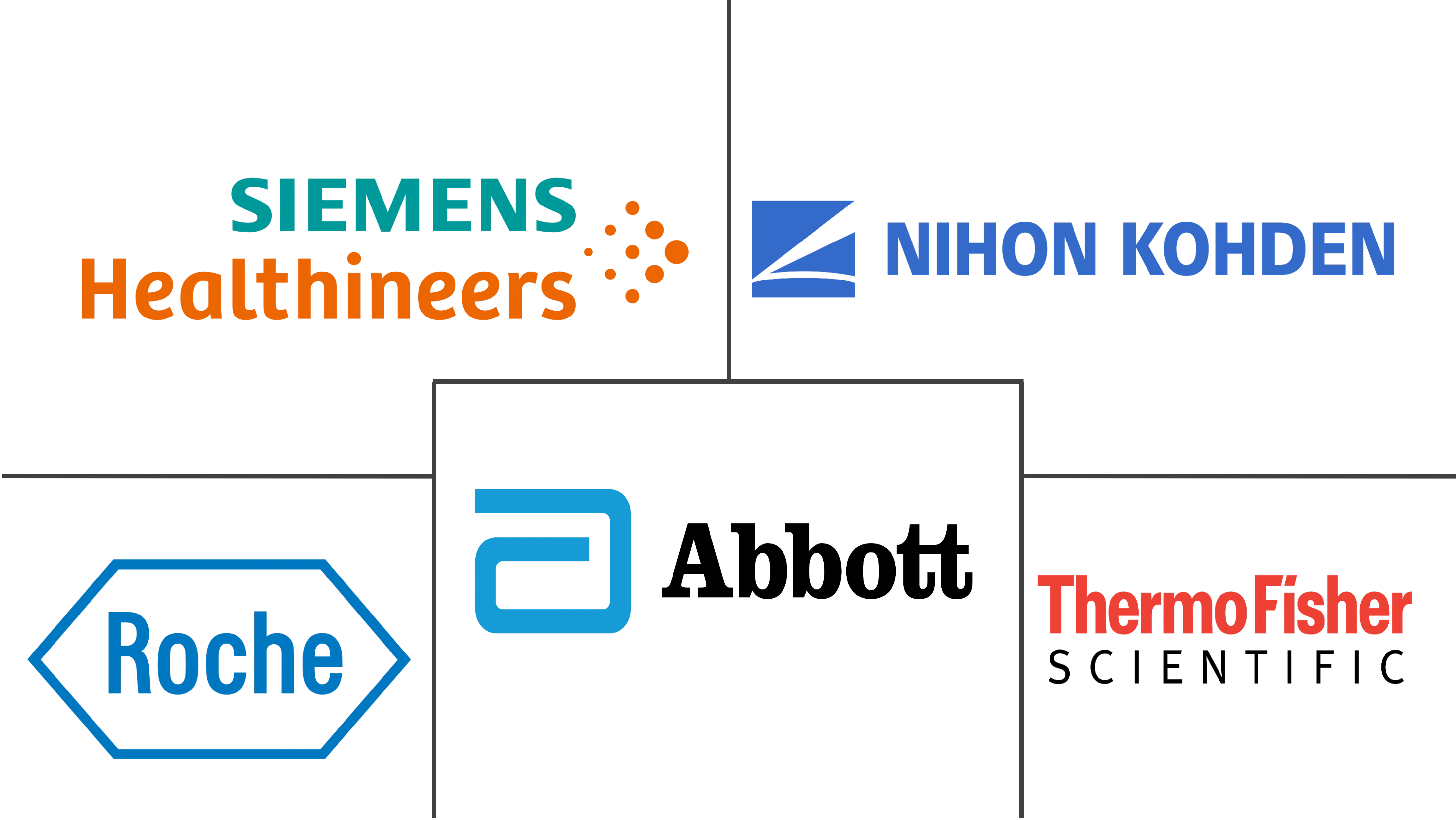Hemostasis Diagnostics Market Size and Share
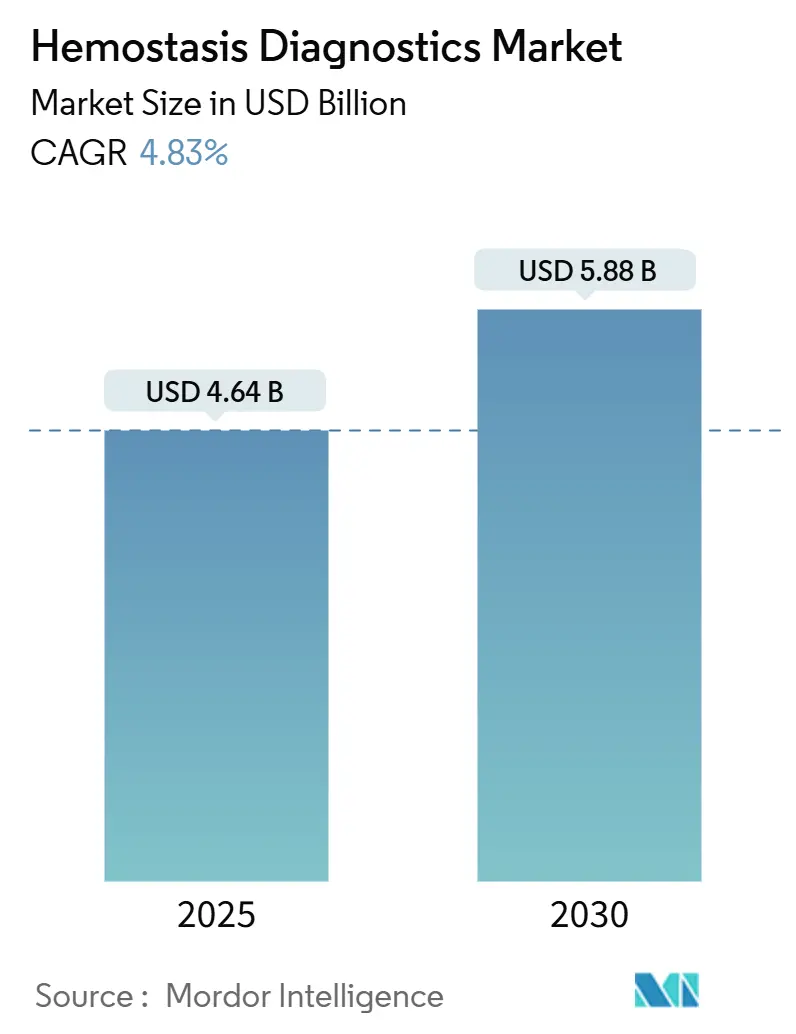
Hemostasis Diagnostics Market Analysis by Mordor Intelligence
The hemostasis diagnostics market stood at USD 4.64 billion in 2025 and is on track to reach USD 5.88 billion by 2030, reflecting a 4.83% CAGR. Demand is buoyed by the rising prevalence of bleeding disorders, rapid uptake of viscoelastic testing platforms, and hospitals’ shift from centralized laboratories to point-of-care coagulation assessments. Automation, microfluidics, and artificial intelligence now underpin new analyzers that deliver reliable results from very small specimen volumes, a feature valued in neonatal, ECMO, and trauma settings. Regulatory tailwinds—including the FDA’s 2025 reclassification of viscoelastic systems into Class II—shorten market-entry timelines, while reimbursement headwinds and interoperability gaps temper the pace of adoption. Competitive intensity increases as suppliers integrate vertically, expand reagent portfolios, and bundle hardware with data-management solutions to secure multiyear laboratory contracts.
Key Report Takeaways
- By product, laboratory analyzers led with 51.55% of the hemostasis diagnostics market share in 2024; point-of-care systems are projected to grow at an 8.25% CAGR to 2030.
- By test, PT/INR dominated with 26.53% revenue share in 2024, while viscoelastic assays are forecast to advance at a 10.15% CAGR.
- By technology, electrochemical and magnetic detection commanded 35.62% of the hemostasis diagnostics market size in 2024; microfluidics is expanding at a 10.52% CAGR through 2030.
- By end user, hospitals accounted for 61.82% of 2024 revenue, whereas outpatient clinics are poised for 9.22% CAGR growth.
- By geography, North America held 37.72% of 2024 revenue; Asia-Pacific is the fastest-growing region with an 8.22% CAGR.
Global Hemostasis Diagnostics Market Trends and Insights
Drivers Impact Analysis
| Driver | (~) % Impact on CAGR Forecast | Geographic Relevance | Impact Timeline |
|---|---|---|---|
| Rising Incidences Of Bleeding Disorders | +1.2% | Global, with higher impact in developed markets | Long term (≥ 4 years) |
| Technological Advancements In Coagulation Testing | +0.9% | North America & EU leading, APAC adoption accelerating | Medium term (2-4 years) |
| Rising Adoption Of Automated Hemostasis Equipment | +0.8% | Global, concentrated in high-volume laboratories | Medium term (2-4 years) |
| Adoption Of Viscoelastic Testing (TEG/ROTEM) For Transfusion Management | +0.7% | North America & EU, expanding to APAC | Medium term (2-4 years) |
| Microfluidic Point-Of-Care (POC) Assays Enabling Decentralized Testing | +0.6% | Global, with early adoption in developed markets | Long term (≥ 4 years) |
| Low-Volume Monitoring Demand In ECMO & Critical Care | +0.4% | Global, concentrated in tertiary care centers | Short term (≤ 2 years) |
| Source: Mordor Intelligence | |||
Rising Incidences of Bleeding Disorders
Global hemophilia prevalence is now believed to be nearly triple earlier estimates, creating a substantial diagnostic gap that hospitals are eager to close[1]Centers for Disease Control and Prevention, “Data and Statistics on Hemophilia,” cdc.gov. The World Federation of Hemophilia records 20,000 new cases each year, yet more than 500,000 people remain undiagnosed worldwide, driving sustained demand for early-screening assays. Precise factor monitoring is essential because prophylactic regimens cut intracranial hemorrhage risk sharply and can lower annual treatment costs that today range between USD 213,874 and USD 869,940 per patient. Governments and payers therefore push for broader access to coagulation panels and point-of-care devices that facilitate routine monitoring outside tertiary centers. As population aging and surgical volumes climb, hospitals increasingly regard the hemostasis diagnostics market as indispensable rather than discretionary.
Technological Advancements in Coagulation Testing
Viscoelastic platforms such as Haemonetics’ FDA-cleared TEG 6s cartridge provide real-time, whole-blood clot dynamics that routine PT or aPTT cannot capture[2]Haemonetics Corporation, “Haemonetics Receives FDA Clearance for New TEG® 6s Global Hemostasis-HN Cartridge,” haemonetics.com. Clinical studies show protocol-guided transfusions cut blood-product use by up to 79% without raising bleeding risk, translating to sizeable cost savings for trauma and transplant centers. Parallel advances in microfluidics, exemplified by Nova Biomedical’s Stat Profile Prime Plus requiring only 90 μL of capillary blood, blur the line between laboratory and bedside testing. Artificial-intelligence-enabled platelet imaging from the University of Tokyo underscores a broader shift toward automated pattern recognition that could soon personalize antiplatelet regimens. These breakthroughs collectively raise throughput, lower sample-volume requirements, and improve clinical decision-making speed within the hemostasis diagnostics market.
Rising Adoption of Automated Hemostasis Equipment
Automation tackles two laboratory pain points—staff shortages and stringent quality control. Sysmex reported 14% sales growth in coagulation products in fiscal-Q2 2025 after scaling production in India to meet demand from high-volume labs. Siemens Healthineers has added more than 60 IVDR-ready assays to its reagents line, ensuring continuity for customers migrating to automated workcells. Roche’s cobas t 711 delivers 390 tests per hour with <3% coefficient of variation, a throughput level that smaller manual systems cannot match. Updated CLIA rules that tighten hematocrit and hemoglobin error limits drive laboratories to replace legacy instruments with high-precision analyzers. Consequently, automated platforms now form the backbone of the hemostasis diagnostics market in reference labs and integrated health systems alike.
Adoption of Viscoelastic Testing (TEG/ROTEM) for Transfusion Management
Combat-care studies reveal a 57% mortality reduction when trauma teams switch from conventional coagulation panels to viscoelastic-guided resuscitation. In liver transplantation, ROTEM pinpoints hyper- or hypocoagulability faster than classical tests, supporting judicious use of cryoprecipitate and platelet concentrates. Quantra’s QPlus cartridge recently earned FDA de novo clearance by demonstrating 72–98% accuracy versus reference ROTEM measurements, widening clinician choice for point-of-care viscoelastic assays. Postpartum hemorrhage protocols that integrate velocity-derived TEG parameters further solidify viscoelastic testing as a versatile tool across care settings. As evidence builds, hospitals incorporate viscoelastic devices into massive-transfusion kits, embedding them firmly within the hemostasis diagnostics market.
Restraints Impact Analysis
| Restraint | (~) % Impact on CAGR Forecast | Geographic Relevance | Impact Timeline |
|---|---|---|---|
| Lack Of Awareness In Developing Economies | -0.6% | Africa, parts of Asia-Pacific, Latin America | Long term (≥ 4 years) |
| Stringent Regulatory Approval Processes | -0.4% | Global, with varying intensity by region | Medium term (2-4 years) |
| Reimbursement Gaps For Advanced POC Devices | -0.3% | Global, particularly in emerging markets | Medium term (2-4 years) |
| Data-Interoperability Issues With LIS / HIS Integration | -0.2% | Global, concentrated in complex healthcare systems | Short term (≤ 2 years) |
| Source: Mordor Intelligence | |||
Lack of Awareness in Developing Economies
Under-recognition of bleeding disorders in many low-income regions keeps diagnostic volumes low despite rising surgical rates. The World Federation of Hemophilia notes large gaps in patient registries, complicating resource allocation. Many clinicians still rely solely on PT/INR because advanced coagulation panels are unavailable or unaffordable at district hospitals. Limited public-health funding competes with higher-profile disease priorities, delaying investment in analyzer platforms. Cultural reliance on traditional therapies further slows uptake of modern diagnostics. Still, localized manufacturing—such as Indian-based facilities that meet international quality standards—demonstrates a viable path to broaden access and lift the hemostasis diagnostics market over the long term.
Stringent Regulatory Approval Processes
Differing global regulations push development costs higher and lengthen launch timelines for innovators. Europe’s IVDR now classifies more than 80% of specialized hematology tests as in-house, obliging labs to conduct extensive validation and vigilance tracking. In the United States, recent FDA warning letters illustrate persistent scrutiny that can halt production and delay upgrades. For smaller firms lacking extensive clinical datasets, the cost of multi-jurisdiction trials is prohibitive, stifling product diversity in the hemostasis diagnostics market. Harmonization efforts are advancing, but until realized they will continue to constrain rapid diffusion of cutting-edge coagulation technologies.
Segment Analysis
By Product: Laboratory Analyzers Dominate, but POC Systems Accelerate
Laboratory analyzers generated 51.55% of 2024 revenue, anchoring the hemostasis diagnostics market with high-throughput capabilities and broad test menus. Automation, advanced reagent stability, and middleware connectivity help large core labs clear staffing bottlenecks while meeting tighter quality-control targets. Point-of-care (POC) systems, although a smaller base, are advancing at an 8.25% CAGR as emergency departments, catheterization labs, and ambulatory surgery centers seek rapid clotting profiles at the bedside. This trend reflects a deeper structural pivot toward decentralized care and value-based reimbursement, which rewards shorter length of stay and lower transfusion cost. The reagents and consumables stream linked to laboratory analyzers remains a resilient profit pool because kits require continual replacement to keep instruments compliant with IVDR and CLIA standards. Miniaturization is blurring category lines, with fingertip micro-sampling and cartridge-based assays allowing analyzers to migrate closer to patients without sacrificing throughput.
In parallel, the hemostasis diagnostics industry is witnessing a surge in hybrid workstations able to toggle between high-volume central-lab mode and stat-testing mode during peak OR hours. Suppliers are bundling instruments with closed-loop reagent contracts, laboratory information system connectivity, and on-site training to secure multiyear deals. Hospitals struggling with skilled-technologist vacancies lean heavily toward platforms that deliver automated calibration, real-time QC, and predictive maintenance alerts. These integrated offerings solidify vendor lock-in and extend the lifecycle of laboratory analyzers, even as POC systems rise.
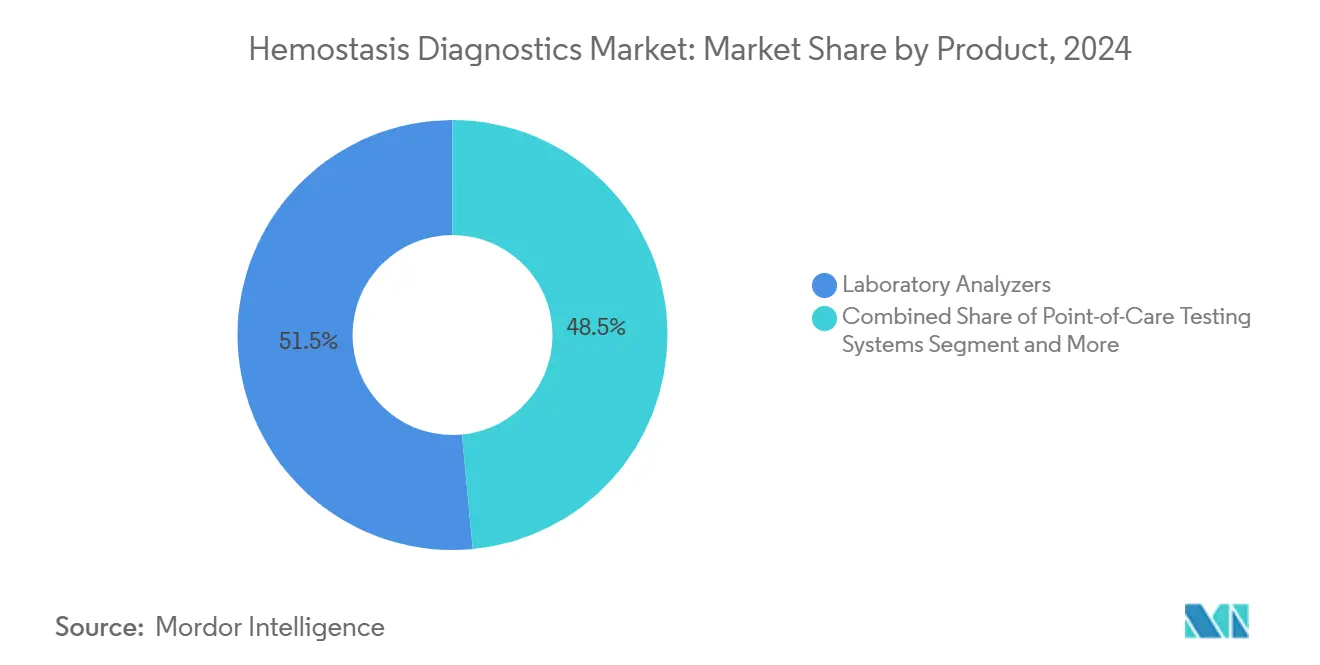
Note: Segment shares of all individual segments available upon report purchase
By Test: PT/INR Still Leads, Viscoelastic Assays Gain Ground
PT/INR retained 26.53% share of the hemostasis diagnostics market in 2024 because warfarin monitoring and surgical screening remain near-universal. Coumadin clinics and pre-op pathways rely on quick PT/INR readouts to adjust anticoagulant dosing and verify readiness for procedures. However, viscoelastic assays are sprinting ahead with a 10.15% CAGR. Surgeons and intensivists value whole-blood clot kinetics for targeted transfusion, a benefit conventional plasma-based tests cannot provide. D-dimer keeps its foothold in pulmonary embolism and deep-vein thrombosis workups, while fibrinogen tests gain traction for obstetric hemorrhage and trauma-induced coagulopathy risk stratification.
New test combinations, such as GFAP plus D-dimer for stroke triage, hint at multiplexed assay panels that could compress workups into a single sample. Even so, traditional aPTT remains indispensable for unfractionated heparin monitoring, preserving its place in the broader portfolio. As evidence mounts that viscoelastic-guided protocols save blood products and reduce ICU stays, tertiary centers add these assays to point-of-care carts, reshaping test-mix revenue within the hemostasis diagnostics market.
By Technology: Electrochemical Platforms Lead While Microfluidics Takes Off
Electrochemical and magnetic detection technologies captured 35.62% market share in 2024, favored for robust signal-to-noise ratios, adaptability to automation, and cost efficiency at scale. Optical detection retains wide use because legacy instruments are deeply embedded, yet faces gradual displacement as labs modernize. Microfluidics, posting a 10.52% CAGR, opens new frontiers by delivering comprehensive clotting profiles from microliter samples—a critical advance for neonates, ECMO patients, and field triage units. These lab-on-a-chip devices shorten analysis time to minutes without the need for centrifugation, aligning with emergency medicine workflows.
Mechanical detection remains relevant where direct clot-formation measurement is paramount, such as orthopedic surgery units monitoring antifibrinolytic therapy. Convergence is evident: next-generation analyzers fuse optical, mechanical, and electrochemical sensors with AI algorithms that flag aberrant patterns automatically. This integration reduces technician intervention and supports remote-monitoring models, strengthening the technology moat that established vendors hold in the hemostasis diagnostics market.
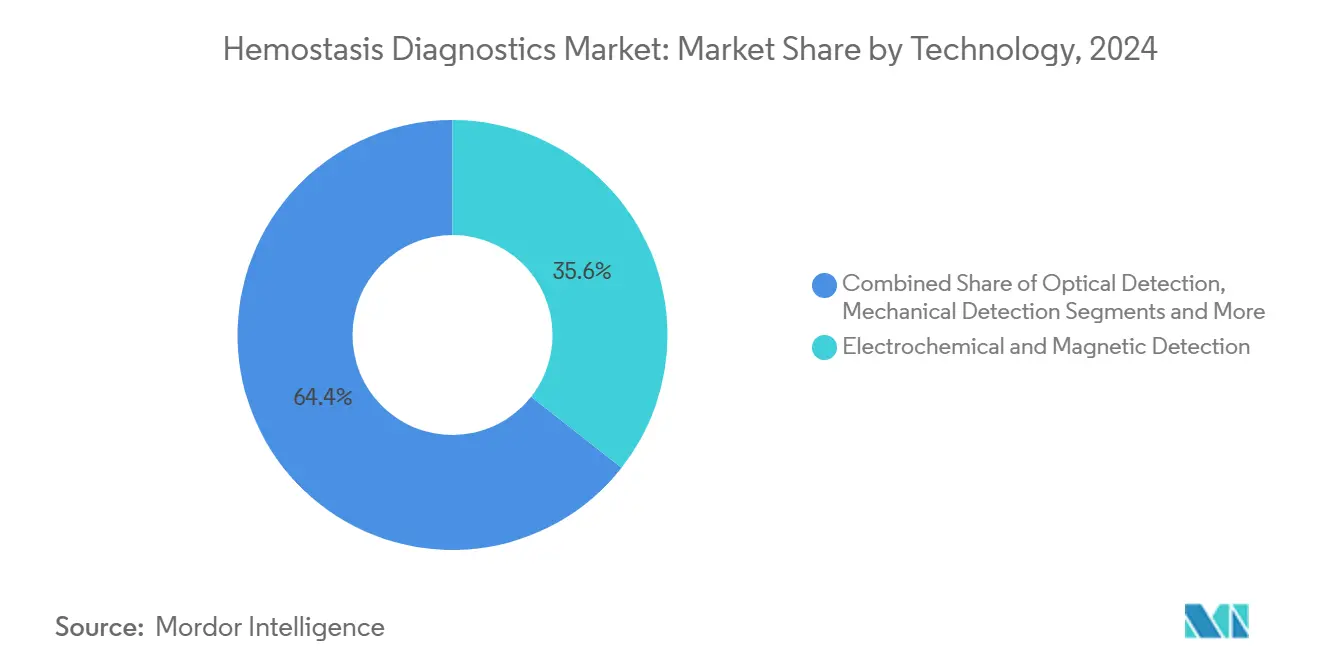
Note: Segment shares of all individual segments available upon report purchase
By End User: Hospitals Remain Core, Outpatient Facilities Surge
Hospitals commanded 61.82% of 2024 revenue because complex surgeries, trauma services, and intensive care units rely on broad coagulation menus under one roof. In-house laboratories favor analyzer platforms that link directly with electronic medical records, safeguarding rapid clinician access to results. Yet outpatient clinics and ambulatory surgery centers form the fastest-growing channel at 9.22% CAGR as procedural care migrates away from inpatient facilities. Point-of-care devices—handheld or benchtop—let clinicians clear same-day cases without the delays of central lab routing.
Reference laboratories continue to service esoteric factor assays and rare platelet-function tests, while blood banks depend on coagulation screening for donor safety and component quality. Digital connectivity now connects all end-users to centralized data lakes, enabling benchmarking of transfusion ratios and reagent utilization across networks. Consequently, vendors tailor service contracts to each segment’s workflow, enlarging their total addressable footprint within the hemostasis diagnostics market.
Geography Analysis
North America led with 37.72% of 2024 revenue thanks to sophisticated hospital networks, early adoption of automated analyzers, and stable reimbursement for advanced diagnostics. The United States’ dense trauma centers and transplant programs generate a steady stream of viscoelastic test demand, while the FDA’s 2025 Class II ruling eases new-device onboarding[3]Food and Drug Administration, “Classification of the Coagulation System for the Measurement of Whole Blood Viscoelastic Properties in Perioperative Patients,” federalregister.gov. Canada mirrors U.S. trends but places greater emphasis on provincial bulk-purchase contracts that favor multi-analyte platforms. Mexico’s ongoing health-system reform drives centralized laboratory buildouts, opening incremental sales channels for mid-tier analyzers.
Asia-Pacific is the fastest-growing geography, advancing at an 8.22% CAGR. China’s volume-based procurement pressures pricing for reagents, yet massive procedure volumes sustain absolute growth. Japan’s aging demographic fuels demand for chronic anticoagulation monitoring, while its technologically adept hospitals rapidly integrate AI-enabled platelet imaging. India’s expansion of indigenous manufacturing—seen in Sysmex’s new facilities—lowers acquisition costs for public hospitals, broadening access to automated hemostasis panels. South Korea and Australia, each with robust trauma and cardiac-surgery programs, continue to install viscoelastic analyzers alongside existing laboratory workstations. These combined forces elevate Asia-Pacific’s share of the hemostasis diagnostics market year by year.
Europe maintains steady mid-single-digit gains amid stringent IVDR compliance. Germany and France adopt microfluidic cartridges swiftly in high-acuity centers, whereas the United Kingdom accelerates point-of-care deployment through National Health Service modernization funds. Southern European nations invest selectively, prioritizing transfusion-sparing technologies to curb blood-product expenditures. The Middle East and Africa trail but show pockets of momentum in Gulf Cooperation Council states where new tertiary hospitals specify centralized coagulation labs from day one. Latin America’s growth rests largely on Brazil and Argentina, which are expanding trauma-care infrastructure and adopting viscoelastic testing in private hospital groups. Collectively, these regional narratives underscore varied but converging trajectories that keep the hemostasis diagnostics market on a positive global slope.
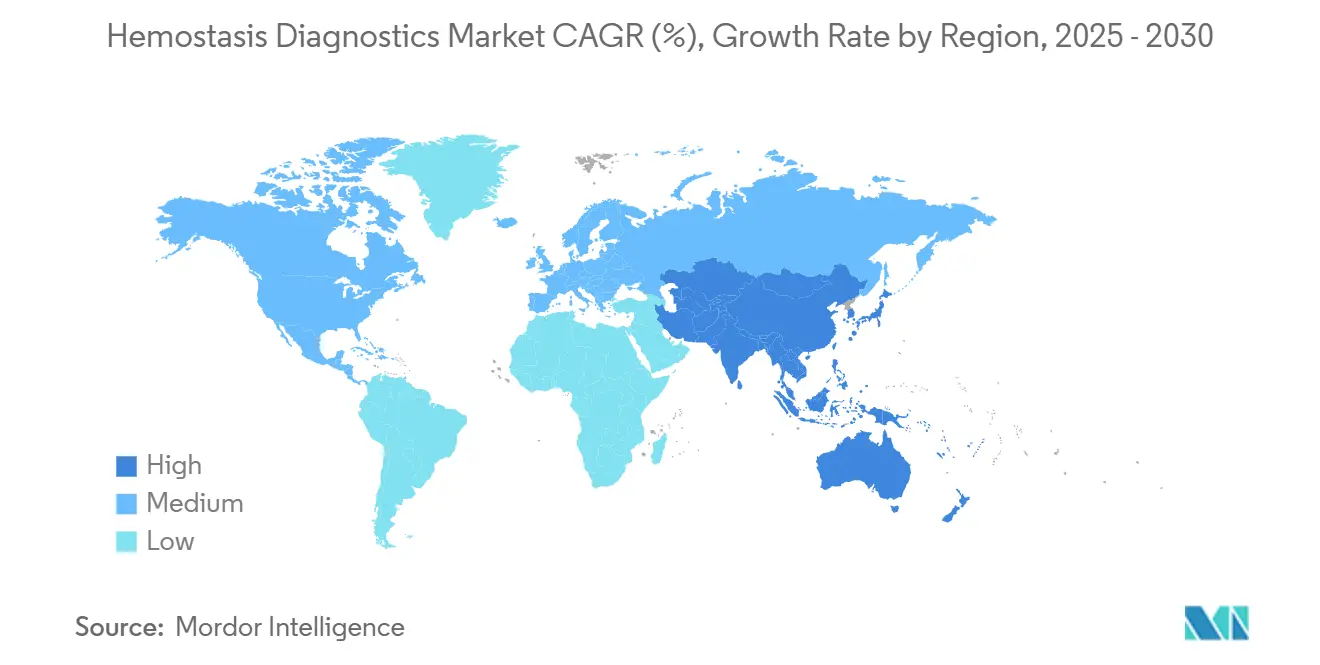
Competitive Landscape
The hemostasis diagnostics market remains moderately fragmented, with leading suppliers pursuing vertical integration and platform consolidation to defend share. Abbott, Danaher, Roche, Sysmex, Siemens Healthineers, and Werfen deploy multi-year R&D pipelines, emphasizing automation, microfluidics, and digital connectivity. Thermo Fisher’s USD 2 billion U.S. innovation program underscores scale advantages that furnish smaller firms with OEM reagents while reinforcing its own production security. Werfen’s unification of subsidiaries streamlines brand architecture, reinforcing its focus on specialized coagulation and point-of-care lines.
Strategic acquisitions intensify. Werfen’s prior purchase of Accriva Diagnostics bolstered its POC catalog, while Merit Medical’s 2025 acquisition of Biolife extended into hemostatic wound-management adjuncts, bridging devices and diagnostics. bioMérieux’s USD 141.8 million buyout of SpinChip adds a 10-minute whole-blood immunoassay platform, signaling convergence between coagulation and infectious-disease testing in near-patient settings. Siemens Healthineers’ OEM pact with Sysmex extends a 25-year partnership, blending extensive reagent lines with next-generation hardware to counter newcomer microfluidic entrants.
Technology differentiation revolves around throughput, sample-volume efficiency, and informatics. Vendors now embed middleware that pushes QC alerts directly to mobile dashboards, shrinking downtime. Cloud-ready analyzers furnish anonymized datasets for algorithm training, an emergent value proposition for customers seeking predictive transfusion analytics. Start-ups working on nanoengineered biosensors or AI-driven imaging target white-space segments such as ultra-rapid thrombosis prediction and non-invasive clot visualization, forcing incumbents to accelerate their own digital roadmaps. As procurement moves to total-cost-of-ownership evaluations rather than instrument price alone, bundled reagent-service contracts and guaranteed uptime become decisive differentiators, shaping competitive contours within the hemostasis diagnostics market.
Hemostasis Diagnostics Industry Leaders
-
Thermo Fisher Scientific, Inc.
-
F. Hoffmann-La Roche Ltd
-
Nihon Kohden Corporation
-
Abbott Laboratories
-
Siemens Healthineers
- *Disclaimer: Major Players sorted in no particular order
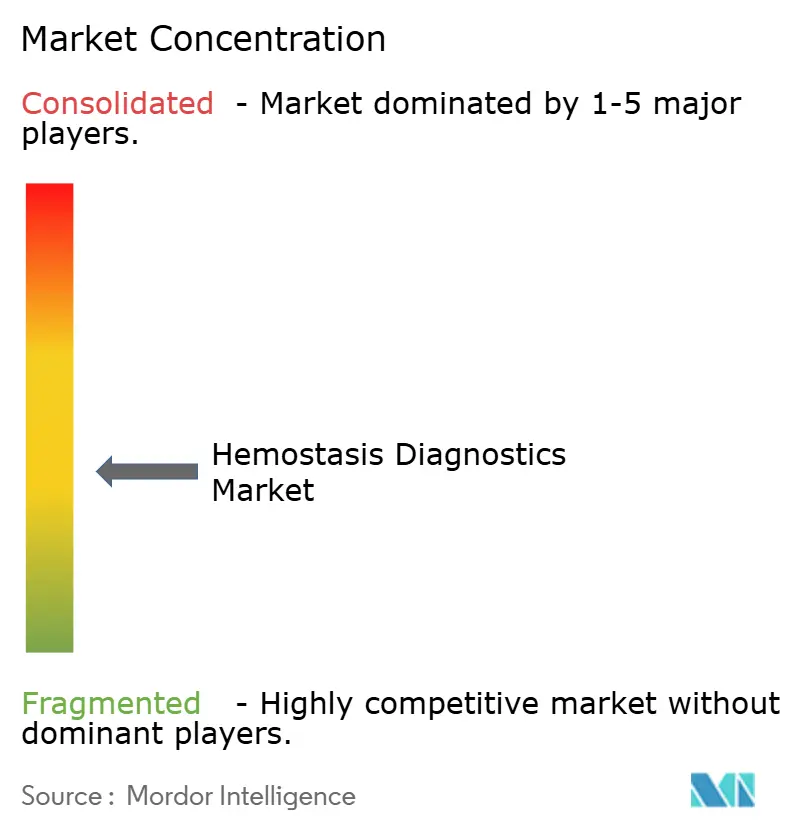
Recent Industry Developments
- May 2025: Merit Medical acquired hemostatic device maker Biolife for USD 120 million to broaden its vascular closure and hemostasis product suite.
- January 2025: bioMérieux purchased SpinChip Diagnostics for USD 141.8 million, adding a rapid whole-blood immunoassay platform capable of 10-minute results.
Research Methodology Framework and Report Scope
Market Definitions and Key Coverage
According to Mordor Intelligence, we view the hemostasis diagnostics market as all new laboratory coagulation analyzers, point-of-care coagulation devices, and their associated reagents or consumables that quantify clot initiation, propagation, or dissolution through tests such as PT/INR, aPTT, D-dimer, fibrinogen, thrombin time, and viscoelastic assays in clinical settings worldwide.
Scope Exclusion: Therapeutic topical hemostats, surgical sealants, and general hematology counters sit outside this study.
Segmentation Overview
- By Product
- Laboratory Analyzers
- Automated Systems
- Semi-automated Systems
- Manual Systems
- Point-of-Care Testing Systems
- Reagents & Consumables
- Laboratory Analyzers
- By Test
- Activated Partial Thromboplastin Time (aPTT)
- Prothrombin Time (PT/INR)
- D-Dimer
- Fibrinogen
- Thrombin Time & Clotting-Factor Assays
- Viscoelastic Tests (TEG, ROTEM)
- By Technology
- Optical Detection
- Mechanical Detection
- Electrochemical & Magnetic Detection
- Microfluidics & Lab-on-Chip
- By End User
- Hospitals
- Diagnostic Laboratories
- Outpatient Clinics & Ambulatory Surgery Centers
- Blood Banks
- Geography
- North America
- United States
- Canada
- Mexico
- Europe
- Germany
- United Kingdom
- France
- Italy
- Spain
- Rest of Europe
- Asia-Pacific
- China
- Japan
- India
- South Korea
- Australia
- Rest of Asia-Pacific
- Middle East and Africa
- GCC
- South Africa
- Rest of Middle East and Africa
- South America
- Brazil
- Argentina
- Rest of South America
- North America
Detailed Research Methodology and Data Validation
Primary Research
Interviews and surveys with biomedical engineers, coagulation laboratory directors across North America, Europe, Asia-Pacific, and Latin America, plus regional distributors validated installed-base counts, reagent pull-through rates, and mid-term price shifts. Follow-up calls tested early forecasts against IVDR and CLIA compliance trends.
Desk Research
Our team first mapped global equipment flows using UN Comtrade tariff codes for clotting analyzers, U.S. FDA 510(k) device clearance logs, and EMA's EUDAMED notices, which illuminate annual unit shipments. Epidemiological series from the World Federation of Hemophilia, WHO Global Health Observatory, and the CDC anchored disease prevalence and procedure volumes that drive test demand. We enriched average selling prices with public 10-K filings, investor decks, and news aggregated through Dow Jones Factiva, while D&B Hoovers provided company-level splits. Patent insights from Questel and import data via Volza sharpened technology-adoption timelines. The sources named are illustrative; many additional open records and professional journals informed data checks.
Market-Sizing & Forecasting
We begin with a top-down demand pool built from surgical procedure counts, inpatient days, and prevalence of bleeding or thrombotic disorders. We then cross-check results with selective bottom-up supplier roll-ups of analyzer shipments and reagent consumption. Key variables modeled include automated-analyzer penetration, reagent price erosion, adoption of viscoelastic POC systems, average tests per inpatient episode, and regional currency movements. Multivariate regression with scenario analysis forecasts each driver. Gaps in bottom-up data are bridged through weighted averages of expert feedback.
Data Validation & Update Cycle
Outputs pass anomaly checks, peer review, and senior analyst sign-off. Reports refresh annually, with interim updates triggered by major recalls, regulatory shifts, or material M&A activity. A final data sweep precedes client release.
Why Mordor's Hemostasis Diagnostics Baseline Earns Trust
Published estimates often diverge because providers choose unequal product baskets, distinct ASP assumptions, and different refresh cadences.
Key Gap Drivers: some firms count only capital equipment, others fold in therapeutic hemostats. A few stretch one hospital survey across five years, whereas our analysts revisit prevalence, price, and procedure data yearly in local currency before conversion.
Benchmark comparison
| Market Size | Anonymized source | Primary gap driver |
|---|---|---|
| USD 4.64 B | Mordor Intelligence | - |
| USD 3.77 B | Global Consultancy A | Excludes consumables and viscoelastic POC devices; uses static 2022 ASPs |
| USD 5.66 B | Industry Data Publisher B | Bundles therapeutic hemostat products; applies optimistic double-digit uptake in emerging markets |
The comparison shows that Mordor's disciplined scope selection, annual source refresh, and balanced assumption set deliver a dependable, transparent baseline that decision-makers can trace back to clear, reproducible variables and steps.
Key Questions Answered in the Report
What is the current size of the hemostasis diagnostics market?
The market generated USD 4.64 billion in 2025 and is expected to grow to USD 5.88 billion by 2030 at a 4.83% CAGR.
Which region is growing fastest?
Asia-Pacific is expanding at an 8.22% CAGR thanks to rising surgical volumes, broader healthcare access, and accelerating technology adoption.
Why are viscoelastic assays gaining popularity?
They provide real-time, whole-blood clot kinetics that guide targeted transfusion, reducing blood-product use and improving outcomes in trauma, cardiac surgery, and transplantation.
How are regulatory changes affecting the market?
The FDA’s 2025 Class II reclassification streamlines U.S. approvals, while Europe’s IVDR imposes stricter validation burdens, collectively shaping product launch timelines.
What role does automation play in market growth?
Automated analyzers boost throughput, reduce human error, and help labs meet tightened quality-control targets, making them indispensable amid workforce shortages.
Which product segment is expected to grow fastest?
Point-of-care testing systems are projected to rise at an 8.25% CAGR as care pathways shift toward outpatient and emergency settings requiring immediate coagulation results.
Page last updated on:
